(Psst: The FTC wants me to remind you that this website contains affiliate links. That means if you make a purchase from a link you click on, I might receive a small commission. This does not increase the price you’ll pay for that item nor does it decrease the awesomeness of the item. ~ Daisy)
These days, we hear talk about “fast fashion,” where you buy for a “micro” season and then throw the clothing out. I must confess, I have sampled once or twice from the clearance rack in stores like this, but never again. The disposable fashion I bought for such a cheap price was falling apart before I could get even a reasonable amount of use out of it. The fabric would pill, stretch, or wear thin almost immediately.
One estimate has the clothing and footwear spending in the US alone at 1.9 trillion dollars in 2019. I can’t really even imagine how much money that is, but I’m here to talk today about saving money, not spending it.
I’m going to share a few stories about some of my “ancient” clothing and the lessons they offer us Frugalites about long-living fabrics. Fast fashion simply isn’t frugal.
My not so fast fashion t-shirt that lasted more than 30 years
When I was 17 and still in high school, I bought this t-shirt at a local mall. It was a Ralph Lauren brand (no collar!) with horizontal bands of bright colors, including blue and red and black. What truly distinguished this t-shirt was the fabric: it was a noticeably thick 100% cotton with a very dense weave. I had no idea when I bought it that day how long it would be with me!
After keeping it for at least 20 years, I passed it along to my mother, who owned it for another five to seven years. It simply was not aging or wearing. It still looked brand new. I saw her wearing it and remembered how much I liked it and took it back from my mother. I wore it for several more years, and then, because I was no longer wearing it, I donated it to a local thrift shop. (Yes, it still fit!!!) I just wasn’t wearing it and thought that someone would enjoy it in all its multicolor glory.
When I donated it, the t-shirt was over 33 years old. Yes, this is how long it is possible for quality clothing to last. Imagine the savings to the planet and our pocketbooks if all clothing was made to this standard.
What lessons did I learn from my beloved t-shirt? Quality fabrics are everything when it comes to longevity. How did I care for it? First of all, I did not wash it every single time I wore it. This is important. However, it did go in the dryer, at least sometimes. Classic looks with classic colors will age well.
My 34-year-old sweater
I was 18 and leaving home to go to university. As a going-away gift, my younger sister gave me a beautiful sweater she had knit herself. Of course, I had seen her knitting it, but she had told me it was for a friend. It was a Fair Isle sweater that was popular in the eighties, with a rich dark green body and a yoke that mixed the dark green with beige, medium brown, and black.
I always kept this sweater, although I didn’t always wear it, as the style had fallen out of fashion. However, I recently pulled it out of my storage suitcase and started wearing it as a coat in the shoulder season of late fall and early winter. This was recently during COVID. I was often in big box hardware stores (when they weren’t locked down) buying hardware items for my cabin build. I was amazed at the people who would approach me to give me compliments on the sweater. One woman owned a similar sweater years ago. “How I wish I hadn’t gotten rid of mine!” she sighed as she complimented me on mine.
What are the lessons to be learned from my 34-year old sweater? The wool in this sweater is remarkable. It has a thickness and weight to it that you don’t see all the time. When I asked my sister about it, she said that she had bought the highest quality wool she could find and afford. It seemed to her that the wool still had some of the natural oils on it.
OK, here’s the final lesson: I have never washed this sweater in all of the 34 years I have owned it. If you are saying “Ewwwwww!” I can provide support for this choice: If I spilled something on the sweater, I just wiped it off with a damp cloth. The dark green color of the sweater has meant that any minor dirt on it has never shown. It smells fresh as a daisy after all these years. I have never worn it without a shirt or turtleneck underneath it, and I can assure those are washed more often than every 34 years! My own feeling is that, by not washing it, I have maintained those natural oils in the wool and prevented any stretching and pilling that washing may have caused.
My uncle’s insulated coveralls
My uncle ran a successful farm drainage business in the 1980s. As the demand for this service reduced, he and my aunt bought a paint store in their small town and worked at that for over 20 years until they retired. After my uncle passed away, my aunt let me adopt a few of his belongings. One of these was a set of insulated coveralls. I carry them in my car during winter as a safety precaution. If I need to be outside for any length of time with a vehicle problem, they are so large that I can throw them on over my clothing to keep warm.
These coveralls are now almost 40 years old. My aunt recalls that they were likely purchased at the local farm co-op. Not only did my uncle use them for years to work on and run heavy equipment outside in our Canadian winters, but his grandsons also wore them while using his tractor to blow snow.
What are the lessons to be learned from these long-lived coveralls? Quality parts last, for one. The zipper is made of heavy metal and it is large, with huge teeth. It is still running smoothly after all these years without a single snag. When I looked at the tag of these coveralls as part of my research for this article, I was not surprised to see that they were made in Canada! Yes, back in the day when we made our own items and quality was king. While quality made in Canada clothing may be hard to come by these days, it doesn’t hurt to examine the zipper of what you are buying to try and assess its sturdiness.
Forget fast fashion. Some things get better with age!
In a world filled with fast fashion, look for “slow” fashion finds and you could save a lot of cash by getting things that will last and last. Could you see yourself using any of the long-lived clothing lessons shared here to select some of your own high-quality items? Do you have a story of a long-lived clothing item you can share with us? Please tell us in the comments.
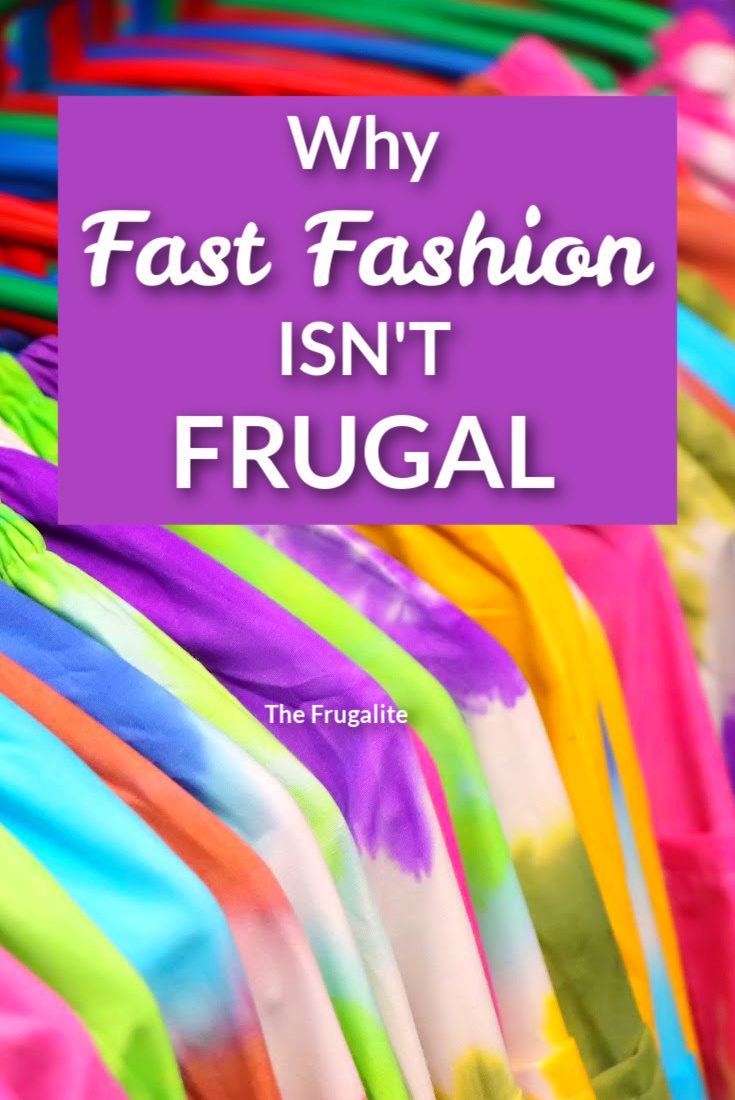

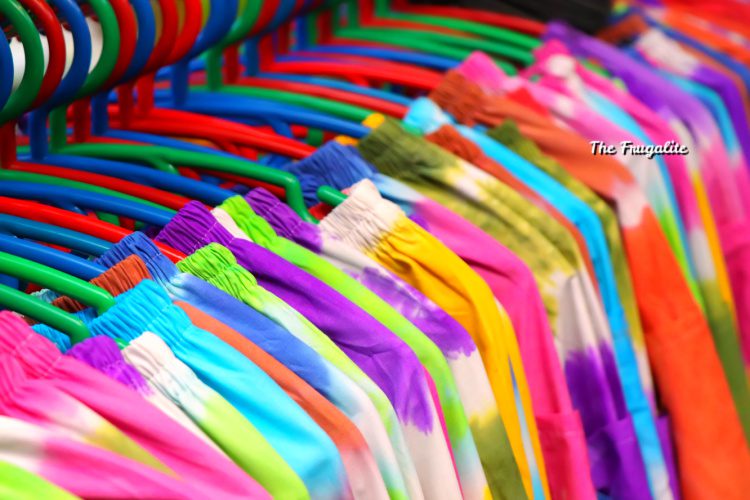




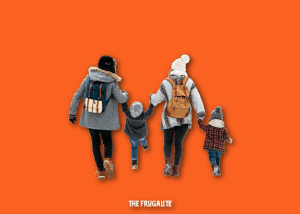

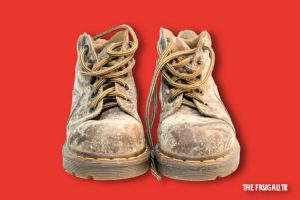
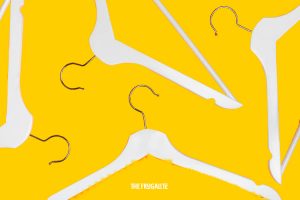

16 thoughts on “Why Fast Fashion Isn’t Frugal”
First of all, thank you, Daisy, for another wonderful and helpful article on frugality. I, too, have several articles of clothing that are more than 20 years old. They’re the ones that were made to last! Good quality material. You can also tell by the stitching of how solid it had been put together. Some things were out based at local thrift stores. Others had been purchased off the clearance rack in the “good quality, high-end, high priced” section. (that’s my favorite places to look for stuff!). Thank you again for your knowledge regarding quality vs quantity.
Hi Carla, Your feedback is gratefully received. Readers like you create the wonderful Frugalite community. GREAT TIP for all our Frugalite readers to look at the stitching when they are shopping. My partner, Peter, and I used to love shopping on the super extra clearance racks of a local upscale department store. We got some wonderful things there. Thanks for your thoughts. I can see we would enjoy shopping together!
In 1984, I saw a sweater in an upscale store that I HAD TO HAVE. Only trouble was it cost $104. I had not the money. It was a brownish wool tweed in a cardigan and was long! I am almost 6 feet and had trouble finding stuff that fit. Anyway, I knew I could not have it.
Back then stores really had after Christmas sales, and guess what I found on the $5 rack? You betcha. The same sweater. Someone must have returned it. I did have the five bucks, and the sweater is still hanging in my closet, well worn but in great shape. And I have not cleaned it either.
Hi Marie, I chuckled when I read the punchline of your message. I AM NOT ALONE!! OK. I was actually a bit concerned about publically writing about not washing my 34 year old sweater, but I thought it was the truth, and helpful. Thanks for that! I was so happy when you got your sweater. It was meant to be…..and you have truly appreciated it all these years. What a great story. Thanks so much.
My thoughts on ‘slow fashion’ clothing versus ‘high fashion clothing’, discount store, big-box stores, medium-level clothing store clothing.
I have three kinds of ‘slow fashion’ clothing, Colette.
1) Clothing that I still wear often. Some of it in the weekly, bi-weekly, and monthly rotations of daily wear. This is very well-made clothing, of quality materials, with excellent workmanship/workwomanship. (Okay. I am not really that politically correct when it comes to things that really matter to me, so a tip-a-the-hat to the women that make most of the clothing in most of the clothing factories around the world for the last couple of centuries.)
It is all the type, style, cut, fit, and usefulness of the lesser clothing I also wear daily that has to be replaced often. The ‘slow fashion’ items are Quality (with a Capital Q if you noticed) jeans, khakis, and pants, shirts, some underwear, cold weather outerwear, etc. Certain other ‘gear’ as opposed to actual clothing, such as certain boots, my leather suspenders, heavy leather money belt, leather wide-brim hat, etc.
2) Clothing that is worn seasonally or for specific purposes two to four times per year. This clothing does not get that much wear, so, therefore, would, logically, last for a long time. And there is some truth to this for a few of the items, I suppose, but I have ‘fast fashion’ versions of some of the clothing and it is worn even less time because it begins to fade, seams begin to pull, threads pull all over it, the material itself begins to rip with the least amount of snag.
So, while some of the seasonal and specific wear clothing might not be up to the standards of the first group, some of these items I still wear are from 10 to 40 years old. And let me tell you, the seasonal items, especially winter items and severe weather and dangerous situation clothing, get some hard use when they are worn.
3) This third category is items that only come out when something specific is occurring or is expected to occur. Much of it is extreme weather clothing, and not just winter weather. Other items are used much like a Halloween costume, for specific circumstances, events, and times. (The few times I have worn a Halloween costume since I was 13-yo have all been composed of regular clothing items, with the exception of a mask or similar item. It is just how I do things.)
A couple of instances of this clothing is a pair of tuxedos that I purchased/was given from a tuxedo rental company. These were high-quality tuxedos, well-made, and expensive, but the company decided to get rid of them because they were ‘too old style’ and the money people wanted to make room for the new, flashy, modern style of… ‘high-fashion, special-event, clothing’? such as tuxedos, dinner jackets, cocktail dresses, and ball gowns. (Not that I wore cocktail dresses or ball gowns, but the salespeople were complaining about the same thing in the women’s side of the business.)
Now, this was over twenty years ago when I obtained the tuxedos. A classic notched collar version first, and then a very pale dove gray, also a classic notched collar but of a slightly different style and cut. I have worn both in recent years and was complimented whenever I did. Highly complimented. And I do know that every man looks good in a tux, even me, but they really seemed to be heartfelt compliments. A Walmart photography studio photographer took some pictures of me in the light dove gray tuxedo when I needed a back cover photo for my second published book. One of those photos of me in the gray tux is the one seen on any of my books that have a picture on the cover. This is just one example of the third category.
Another is a set of leather sandals I bought in the 90s. I cannot abide flip-flops and needed something to wear at the beach that would not fill with sand and cut my feet to pieces. I went for quality, comfort, and suitability to my feet. With some consideration ‘for Geez! What just happened and what is going on?”
These are all leather, except for the tread, and one internal sole layer for strength and support. Buckles, not velcro. They are beautiful sandals, bringing me more compliments when I wear them. Which is seldom. I have no worries that there might be a problem with them when I am out and about. I am still a prepper, even if I am out and about in a Hawai’ian shirt, Hawai’ian shorts, and a straw hat. (Yes, I bought those items for a woman, whom I highly respect, that wanted a Hawai’ian-themed birthday party. Note that I was the only one fully dressed the way one would attend a Hawai’ian luau. A few had a shirt, one had the shorts, many wore flip flops.)
The sandals are just shy of 30-years old.
Some of the items in this third category might not last as long if they were in a regular rotation of wear and cleaning. I do not think so, because while some of them might not be exactly the same quality as that in the first category, they are all equal or very close.
I am 68 years old now and have had plenty of time to test the things discussed. Still everything is:
Just my opinion.
Jerry, I am 72 and have not had to buy shoes in 20 years. I tend to buy loafers in real leather and take good care of them. I do not wear them outside in the rain or snow, for instance, and they are polished as needed. I feel that jogging shoes are a rip off both in price and wearability, so I bought a pair of leather walking shoes that have lasted this long. I might have to have them resoled, but that’s OK.
Neither fast food nor clothing has much appeal to me.
Hi Marie, I am writing to you wearing my real leather loafers from a high end shoe producer, Rockport. They are sooooo comfortable. They are dark brown and don’t show the dirt. These kind of quality shoes are definitely worth resoling. I’m not there yet, but they would be worth it. The best part? I bought them in like new condition from our local thrift shop! Glad to meet another slow fashion fan, especially in the footwear category! Thanks for sharing!
Hi Jerry, this is a wonderful response that goes into very helpful details about the different categories of clothing we all wear. My favourite item you described were your sandals. They sound fabulous! I am quite sure i would love to own a pair myself. Good for you. Thanks for being so generous in your sharing with the Frugalite community. Much appreciated!!!!!
Something I read years ago from a lady who had all couture clothing: Her clothes were sized to her, made to last, and she wore the same wool, linen and high quality basic layers year after year. She suggested if a person wants to follow current fashions then use smaller accessories like scarves, gloves and jewelry and sometimes one of whatever blazer/overlayer was “trendy.” She kept anything she bought that she liked because the good stuff goes in and out of fashion in a cycle. She said if you look at people with real wealth over generations, they don’t follow clothing trends, they have classic styles tailored to them. In some cases they’re wearing styles decades out of date according to fast fashion, but they’re instantly recognizable as high quality.
Now that I’m 60 I can look back and see how often things like jean styles came back around over the years. Bell bottoms are the only trend I can think of that hardly anyone wanted to reintroduce. I have a jeans skirt in my closet which comes back in style every few years, and in the meantime it’s comfortable to wear around the house. Button down shirts in good quality material are never out of style and they wear forever.
I really like the “new” minimalist idea of a capsule wardrobe made up of 5-7 really good quality pieces, then adding in something that’s trendy if you feel the need. If you’re gonna buy trendy stuff make sure you actually love the look and will keep using it because it suits your personal style.
I think it says a lot about fast fashion that when everyone was on lockdown and started cleaning out their closets the thrift stores were overwhelmed and had to stop accepting donated clothing. There was just that much lying around that people weren’t even wearing, I bet millions of dollars worth that people worked hard to buy and now it’s in sacks at the landfill.
Hi Mme. Homebody, Thanks for a fantastic comment! Yes, I remember bell bottoms….I’m not voting for their return either. I love the points you make about classic pieces with updated accessories. While I don’t have the capsule wardrobe of a new minimalist, I own very few clothes now. I am so thankful that I live in a rural area where little to no emphasis is put on what to wear to the grocery store! I don’t want to contribute to more sacks in any landfill. Thanks for taking the time to share with the Frugalite community!
Oh yeah! I have a hoodie purchased at a yard sale for $1 that I’ve used for a number of years. It has many happy memories associated with it and I look forward to using it a few years more. Pretty good ROI for $1, I’d say!
Yeah, forget trendy. Go for rummage sale and thrift store treasures! I’ll keep that point about stitching in mind too.
Hi Jayne, Your ROI on that hoddie would make most Wall Streeters envious, I would say! There is something so satisfying about a find like that. The yard sale sourcing makes your long lived hoodie all the sweeter! I do enjoy my thrift store shopping….I find I can even learn about fabrics and what a good cut is by looking around. Thanks for your thoughts. As always, you are on the cutting edge of Frugal, Jayne!
I’m buying clothing for our family with multiple children, who get dirty and grow quickly. 🙂 I do buy a quantity of cheaper clothing items, because I have to change and wash their clothes often! But everything comes from Thrift, consignment, or clearance. And fairly frequently, an item is so dirty or torn I just throw it away, figuring I got my 50c worth of value out of it. (A child’s dress covered in hundreds of tiny burrs is not worth my time or money to try to save or repurpose!) 🙂
For outerwear and pants, I do try to find quality in hopes the item will last through several children. Whenever I can find name brand, adjustable boys pants, that’s a score! These are also the items I will tuck away in the attic until someone else will grow into them. (The girls can get away with wearing some boy’s clothes, although it doesn’t work the other way around.)
My oldest is in adult sizes now, so I’ve definitely been buying quality items for them. If they happen to outgrow those, the item can be handed down. But there’s a good chance their clothes now could last for many years!
For myself, I have adopted a Capsule wardrobe. I try to have pants and tops and sweaters that will mix and match, in classic styles. I also keep 1 suit jacket and a dress. I like the charts online that show how 12 or 15 pieces can make up dozens of different outfits! For day to day, I keep t-shirts and zip up Sweatshirts, and the layers work great for most of the year. I also have several pairs of exactly the same cut of jeans–once I found some I liked, I bought more, and have been alternating them and rarely washing as others have mentioned. I do have high quality winter wear and boots – – my chore boots are about 25 years old now! These items cover my needs from work to chores to a special occasion.
Dressing a family definitely takes a mixed approach. 🙂
Hi IA Mom, Wow! You have shared some valuable strategies for dressing a family here. I especially liked how you described your “mixed” approach in terms of what items you look for in the cheaper clothing and which ones you search for the quality. Thanks so much for sharing your thoughts. There are many Frugalite families that will benefit from this, I’m sure!
I too have a multi level approach to clothes. The first level are the backbone of my wardrobe, they are inexpensive basics. Hear me out on this…it isn’t that they are trendy but some clothes wear out no matter the quality. I have chub rub. It doesn’t matter if I spend $10 on a pair of pants or $100 sooner or later the pants wear out. I don’t find that $100 pants last 10x longer than $10 pants. Why spend more? The next level is my high quality keepers, these are things I buy for a “lifetime”. Though they do occasionally Wear out most will outlive me and some have even outlived my father to become mine. These are wool and leather coats and leather purses, some shoes like my Dr Martens and LL Bean ducks. Good stuff worth paying up for because you will have them forever. Also I include underwear here. There is only one brand/type of undies I like and they usually last about 15 years, so yeah they are kind of expensive but I am still wearing underwear from before I was married and I have been married over 13 years. Totally worth it to me. Then are my “collectables”. I collect and wear t-shirts and canvas sneakers like Converse and vans. I buy these items because I like them so much. I wear them but usually not enough to wear them out and I take super good care of them. I wash them inside out in cold and line dry so they will last. Included with this are all the crazy club clothes my mother made me in the 90’s and such, clothes with memories. The last type of clothes I own are the “fashion” pieces. I buy these in spring and fall but I usually buy them from the thrift store and donate them back when I’m done with them. This is the stuff for whatever “look” I’m going for. I really should just put them away because I usually only recycle through a few looks but it is nice to have a few fresh pieces now and again and at thrift store prices it is usually under $100 a year.
My husband wears clothes out. We buy him basics in good quality but affordable prices, he wears them until they fall apart, we buy more. I don’t think spending more on his clothes would make them last longer, he just has a physical job and is hard on clothes. My son is the same plus he is growing. I don’t buy him a ton of clothes but he isn’t into clothes either. As long as he has comfortable clothes that fit he is happy.
My daughter loves clothes, she is also lucky enough to get amazing hand me downs and we do give her special clothes as gifts.
Both kids need uniforms for school. I buy a one week set on sale at children’s place most years. Unfortunately they often outgrow Or destroy them by the next fall. When they were younger I passed my son’s clothes down to my daughter but recently she developed some curves and unisex and boy clothes just don’t fit her properly. We donate any outgrown but still in good shape uniforms to the school.
I wouldn’t say we are into “fast” fashion but we do buy cheap basics for things that wear out or are outgrown frequently.
Hi Kay Mae, Thanks for taking the time to share this detailed comment on your clothes buying strategy. I do think it’s important to have balance: sharing which items you do buy cheaper items in is helpful to all readers. Like you, I sometimes just like to buy something fun or in fashion. I think this is a part of our human nature: that we like some novelty/something new and fresh (at least to us). I think you’ve shared some valuable insights on how to balance all our needs while buying clothing for a whole family, with kids in uniforms!